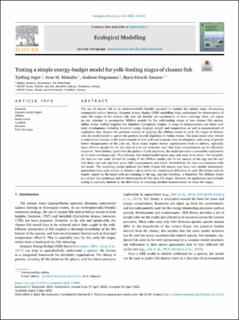| dc.description.abstract | The use of cleaner fish is an environmentally-friendly approach to combat the salmon louse, threatening commercial salmon farming. Dynamic Energy Budget (DEB) modelling helps understand the bioenergetics of early life stages of the cleaner fish, and can thereby aid optimisation of their culturing. Here, we report on our attempts to parametrise DEBkiss models for the yolk-feeding stages of two cleaner fish species, ballan wrasse (Labrus bergylta) and lumpfish (Cyclopterus lumpus). A range of measurements was taken over early development, including biometry (using imaging), weight and composition, as well as measurements of respiration rate. Despite the previous success of applying the DEBkiss model to early life stages of Atlantic cod, the model failed to capture the patterns of yolk depletion for ballan wrasse. The main issues were related to substantial changes in the water content of both yolk and structure over development, and a stop of growth before disappearance of the yolk sac. These issues require further experimental work to address, especially more efficient proxies for the dry mass of yolk and structure, such that these compartments can be efficiently separated. Nevertheless, apart from the pattern of yolk depletion, the model provides a reasonable explanation of all traits simultaneously. This indicates that model modifications may only need to be minor. For lumpfish, the data set was quite limited for testing of the DEBkiss model, due to the opacity of the egg and the fact that there was only one time point with measurements post hatch. Nevertheless, the data are consistent with the model. The modelling results indicate that both cleaner-fish species may have very similar bioenergetic parameters (and quite similar to Atlantic cod as well); the conspicuous difference in early life history may be mainly caused by the larger yolk provisioning in the egg, and late hatching, in lumpfish. The DEBkiss model is a simple and promising tool for bioenergetics of fish early-life stages. However, its application and in-depth testing is currently limited by the difficulties of obtaining detailed measurements on these life stages. | en_US |

